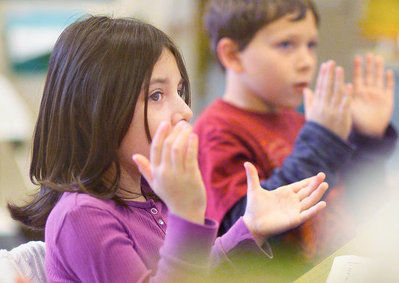
Seven-year-old Cani Johnson flashed a toothy grin as she stepped on a giant floor piano during a music lesson at San Lorenzo Valley Elementary School. Behind her, several other second-graders lined up excitedly for a turn to test their newly acquired note and pitch knowledge.
“The kids were starving to have this in their lives,” music teacher Beth Hollenbeck said. “They are so responsive, musical and enthusiastic. They’re like little sponges.”
The class — the most consistent music program for kindergartners through third-graders since the 1970s, when Hollenbeck’s uncle Dr. Bob Ruppel ran it — wouldn’t have been possible without an anonymous $20,000 donation given to the school last summer.
Principal Michelle McKinney said the donation was met with delight and open arms, especially in light of the budget cuts to education.
“The family that gave the donation said they wanted to anonymously help during this time to keep the great enrichment experiences alive in school,” McKinney said. “Because of the way budget cuts work, we couldn’t use the money to hire people back that had to be let go.”
The consensus was that the school needed music and science for the primary grades, McKinney said.
Half of the donation is going toward music classes, and the other half will pay for science curriculum that will start during the second half of the school year.
“The teachers are thrilled, because this provides music in the classroom, and the kids absolutely love it,” McKinney said. “We’ve had music and science for the upper grades, but not for the primary before this.”
The classes are an important piece of education that had not been in place before now, said Hollenbeck, who was hired as a contractor to teach Monday through Thursday at the beginning of the school year.
“There wasn’t a consistent music program for K-3 students before that,” Hollenbeck said. “This one is definitely geared for the long-term.”
And it’s not just a choir class, Hollenbeck said. Her curriculum is based on California educational standards for visual and performing arts, and the lesson plan includes listening and oral response, recognizing musical symbols and terminology, and clapping out beats.
Hollenbeck studied music and voice while she was in college and has recorded two albums. She said she was turned on to music when she attended San Lorenzo Valley Elementary School before the arts started being axed from education budgets. Her uncle taught the music program at the school in the 1970s.
“Before this, that was the last time there was a music program,” said Hollenbeck.
Music was more available then than it is now, she said, but she’s working to change that.
“In the past, there was no way we could get to state standards,” Hollenbeck said. “But instead of getting to high school and starting from scratch, I’m teaching the building blocks now.”












